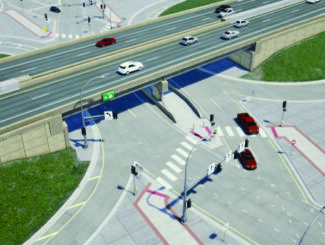February 12, 2024
By Saeed Sobhi, Regional Design Manager, WSB
Emergencies will happen. Disasters will happen. Communities must have thorough plans in place to prepare for and respond to a multitude of potential emergencies, ensuring public safety and preservation of property.
As communities face more extreme weather and other climate change related events such as fire, flooding, and mudslides, exploring resiliency and sustainability of assets and advance planning in emergency response and evacuation are critical. Will a road or a bridge need to be expanded? Are current facilities like local schools capable of providing shelter during an emergency? If tragedy strikes and thousands of vehicles need to go through one road to evacuate, can that path handle the strain? Are communication tools and protocols in place to effectively and efficiently notify residents to give them instructions? Do response agencies have the proper tools and resources? Properly developing emergency response traffic management plans is critical to safety.
Recent investments from the federal government like the Infrastructure Investment and Jobs Act (IIJA) have provided renewed opportunities for becoming more resilient to extreme weather events, but also to tackle sustainability goals. For example, the IIJA provided $110 billion for repairing and updating infrastructure. In the process of constructing an emergency response plan, roads and bridges and other key infrastructure that require updating can be noted allowing the city or county governments to apply for this newly accessible aid. The IIJA also provided an additional $50 billion with the explicit goal of making infrastructure more resilient to extreme weather events. The combination of these types of investments both in repairs and weatherizing updates provides ample opportunity for communities to take initiative in formulating emergency response/traffic management plans and ensuring their infrastructure will hold up in the face of disaster.
Here are some ways that communities can think about building robust emergency response plans that are smart and sustainable.
Think About Roadways
Just as the average student grows up learning where to go during a fire drill, a community needs a clear picture of how to respond in case of an emergency. This is where an emergency response plan comes in.
Using Colorado as an example, communities faced severe natural fires, flooding, and mudslide events that required extensive response work and evacuations. Communities in mountainous regions are especially susceptible as a severe mudslide can cut off road access. The size of these recent events and the damage caused has led more communities to recognize the need for sustainability and resiliency measures both to defend themselves from climate related disasters, but also to attempt to prevent future events. Proper design, routine inspection and systematic maintenance of roads and bridges is a key component of preparedness.
Preparedness also requires detailing clear evacuation routes and easily accessible paths for emergency responders. Making note of not only the best currently available paths, but also what areas may be improved or expanded. If a specific bridge is developed to include additional lanes for traffic, would it become a higher priority evacuation route? Also, are there roads where counterflow can be implemented to expedite evacuation? Having a detailed perspective of the roadway system and its capabilities is tantamount in emergency planning.
Navigate Available Facilities and Capabilities
Environmental threats can come in a wide variety of forms like power outages during freezing temperatures, wildfires that encroach on communities, or heavy rains that flood residential areas. These environmental hazards, among others, are affecting people and communities all over the country. One matter that all of these have in common is what happens once people have evacuated? These abnormal weather events like the recent freezing temperatures and power outages in Texas reveal a greater need for facilities that can handle the strain of housing evacuees and are designed with the goal in mind of weathering the storm.
Emergency plans need to include the capabilities for people to reach shelter, but also the ability for facilities to handle becoming a shelter. Event centers or schools are evaluated on how many people they can accommodate as an impromptu evacuation shelter. Do the facilities have enough capacity and the necessary amenities like cooling or heating systems? Knowing a facility can provide space and heating when a nearby residential area faces power outages in subzero temperatures will be a life saver.
Collaborate to Build Success
The resiliency of emergency planning requires collaboration across local governments. The different stakeholders in the development of an emergency plan include local city government, city emergency responders like police and fire rescue, the state’s department of transportation, neighboring municipalities that share the primary roads and bridges used during evacuations, and counties for when the plans extend beyond the reach of one individual community.
Collaborative efforts come in the forms of understanding what equipment is available for communicating during emergencies or for emergency responders to properly respond. On many occasions the local department of transportation holds jurisdiction over specific roadways or can aid in developing plans for parking and access to highways. These evacuation zones can be made digital so communication is fluid through the various agencies and the residents affected can be notified as soon as possible.
How WSB Can Help
With more attention being placed on sustainability and eco-friendly construction projects, attention should be given to maintaining and improving resiliency for the growing number of extreme weather events brought on by climate change. From designing sustainable infrastructure to helping communities create in-depth emergency management plans, WSB is here to help.
Our team has rich experience covering a variety of specialties that can help communities prepare. Our team has meaningful experience developing and supporting implementation of incident management plans and emergency traffic management response plans, as well as facilitating collaboration and consensus building among stakeholders.
Saeed has 25 years of experience with the Colorado Department of Transportation (CDOT) where he worked on transportation planning, project design and delivery, transportation system management and operations, planning for operations, incident management, traffic engineering, and asset management and maintenance. He has special interest and focus on Transportation System Management and Operations (TSM&O), and application of technology in Transportation..
ssobhi@wsbeng.com | 720.512.2891


